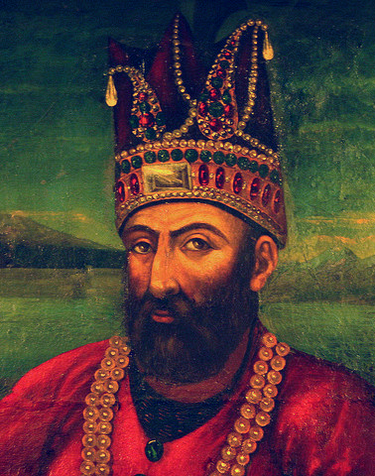Prince of Lasanod
Eid trim pending

Early life
Nader Shah was born in the fortress of Dastgerd(Iran) into the Qereqlu clan of the Afshars, a semi-nomadic Qizilbash tribe settled in the northern valleys of Khorasan, a province in the northeast of the Persian Empire. His father, Emam Qoli, was a herdsman who may also have been a coatmaker.
At the age of 13, his father died and Nader had to find a way to support himself and his mother. He had no source of income other than the sticks he gathered for firewood, which he transported to the market. Many years later, when he was returning in triumph from his conquest of Delhi, he led the army to his birthplace and made a speech to his generals about his early life of deprivation. He said, "You now see to what height it has pleased the Almighty to exalt me; from hence, learn not to despise men of low estate." Nader's early experiences did not, however, make him particularly compassionate toward the poor. Throughout his career, he was only interested in his own advancement. Legend has it that in 1704, when he was about 17, a band of marauding Uzbek Tartars invaded the province of Khorasan, where Nader lived with his mother. They killed many peasants. Nader and his mother were among those who were carried off into slavery. His mother died in captivity. Somehow, Nader managed to escape and returned to the province of Khorasan in 1708. Living under the most desperate circumstances, he and his friends stole a flock of sheep and sold them in the market. With the money they made, they fled into the mountains.
Tiring of life as a fugitive, Nader presented himself to a Persian nobleman. He was employed as a courier, to deliver important messages to the royal court at Isfahan in 1712. A second courier accompanied Nader on these missions. On one of their journeys, he murdered his fellow courier either because his companion was slowing him down or, as is more likely, because he wanted to be the sole carrier of messages to the royal court.
At the court of Sultan Husayn in Isfahan, Nader gave such a convincing account of the reasons he had been forced to kill his companion on the road that he was pardoned and sent back with presents and answers to the letters he had brought. However, upon his return he saw that his master was quite upset. By the look on his face, Nader assumed that the nobleman planned to kill him. He had also fallen in love with the nobleman's daughter, but his master flatly refused to consider letting them marry. Because of his disappointment and in order to defend himself, Nader killed the nobleman and fled into the mountains with the daughter, where their first son, Reza Qoli Mirza, was born. Other servants of the dead nobleman joined Nader and they formed a gang of robbers operating in the province of Mazanderan.
Fall of the Safavid Dynasty
Nader grew up during the final years of the Safavid dynasty which had ruled Iran since 1502. At its peak, under such figures as Abbas the Great, Safavid Persia had been a powerful empire, but by the early 18th century the state was in serious decline and the reigning shah, Sultan Husayn, was a weak ruler. When Sultan Husayn attempted to quell a rebellion by the Ghilzai Afghans in Kandahar, the governor he sent (Gurgin Khan) was killed. Under their leader Mahmud Hotaki, the rebellious Afghans moved westwards against the shah himself and in 1722 they defeated a force at the Battle of Gunabad and then besieged the capital, Isfahan. After the Shah failed to escape or to rally a relief force elsewhere, the city was starved into submission and Sultan Husayn abdicated, handing power to Mahmud. In Khorasan, Nader at first submitted to the local Afghan governor of Mashhad, Malek Mahmud, but then rebelled and built up his own small army. Sultan Husayn's son had declared himself Shah Tahmasp II, but found little support and fled to the Qajar tribe, who offered to back him. Meanwhile, Persia's imperial neighboring rivals, the Ottomans and the Russians, took advantage of the chaos in the country to seize and divide territory for themselves. In 1722, Russia, led by Peter the Great and further aided by some of the most notable Caucasian regents of the disintegrating Safavid Empire, such as Vakhtang VI, launched the Russo-Persian War (1722-1723) in which Russia captured swaths of Persia's territories in the North Caucasus, South Caucasus, as well as in northern mainland Persia. This included mainly, but was not limited to, the losses of Dagestan (including its principal city of Derbent), Baku, Gilan, Mazanderan, and Astrabad The regions to the west of that, mainly Iranian territories in Georgia, Iranian Azerbaijan, and Armenia, were taken by the Ottomans. The newly gained Russian and Turkish possessions were confirmed and further divided amongst themselves in the Treaty of Constantinople(1724).



